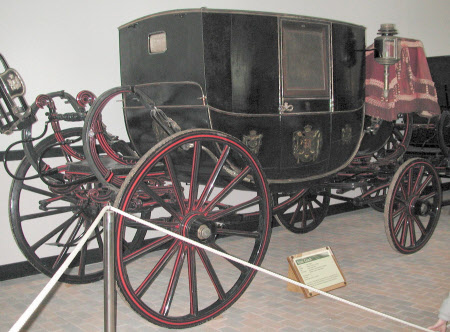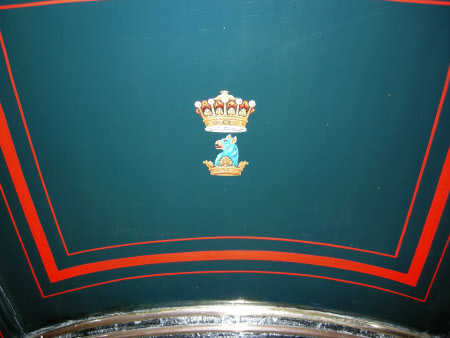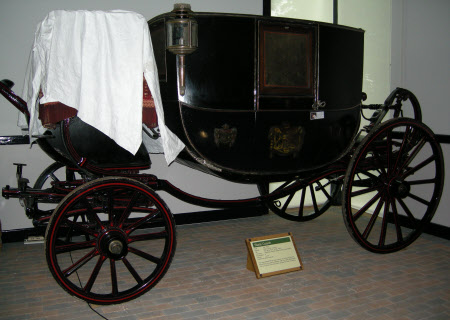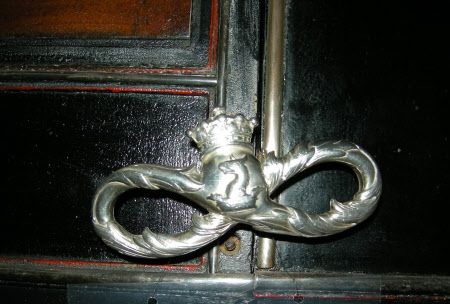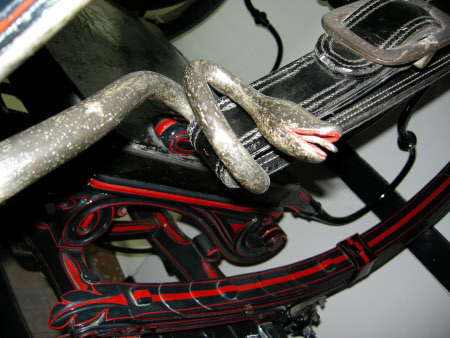State coach
Peters and Son
Category
Carriages & other vehicles
Date
circa 1860
Materials
Painted wood body with taffeta upholstery and four iron shod wheels.
Measurements
227 x 448.5 x 182cm (7ft 5 1/3in x 14ft 8 1/2in x 5ft 11 2/3in)
Place of origin
London
Order this imageCollection
National Trust Carriage Museum
NT 272916.1
Caption
State carriages were generally kept in town and not, as one might expect, at the country estate. This was because they were mostly required for events held in town and in any case would not have been suitable for the journey between town and country. The main difference between this and the chariot is that a coach seats four inside the body, and therefore has a seat ahead of the doors and one behind them.
Summary
State Coach built for the Earl de la Warr by Peters and Son of London, circa 1860. State Coach (four wheels) for a team of horses. A typical 19th century state coach with hammer cloth, coachman’s seat and Salisbury boot, footman’s cushion and hind standards on perch carriage. The interior if of striped gold taffeta. This carriage is sprung on c springs and under springs.
Full description
This coach was built by Peters and Son, London, for George John Sackville-West, 5th Earl de la Warr (1791-1869), a politician who served as Lord of the Bedchamber to both George III and George IV and who was appointed Lord Chamberlain to both Sir Robert Peel and Lord Derby. Earl de la Warr married Elizabeth, daughter of the 3rd Duke of Dorset at Knole in Kent in 1813. Although they spent most of their married life at Buckhurst Park in East Sussex, the coach was always kept at Knole and remained there until the 1980’s when it was moved to the Carriage Museum at Arlington Court. Being a coach, it could carry four passengers in the body. It would have been pulled by a pair of horses driven by a coachman. The decorative seat cloth covering his seat is called a hammer cloth. Two footmen would stand on the footmen’s cushion, the padded platform behind the body. The silver plated fittings and furniture are unusually fine, including crested door handles, snake head body loops decorated with acanthus leaves, and heavily ornamented lamps. The interior trimming, although sadly dilapidated but currently being conserved, is in beautiful ivory silk and Melton cloth, with superb laces (the coach trimmer’s term for braids). It probably dates from the mid 1800s.
Provenance
George John Sackville West, 5th Earl de la Warr married Elizabeth Sackville daughter of the 3rd Duke of Dorset. They were married at Knole in 1813 but apparently did not live there until 1864. George died at Knole five years later in 1869.
Marks and inscriptions
On nearside side panel.: Crest On offside side panel.: Crest On panel blind : PETERS & SONS BUILDERS, LONDON On front nearside axle cap.: PETERS & SON LONDON On front offside axle cap.: PETERS & SON LONDON On rear nearside axle cap.: PETERS & SON LONDON On rear offside axle cap.: PETERS & SON LONDON On front nearside axle components.: COLLINGE PATENT On front offside axle components.: COLLINGE PATENT On rear offside axle compontents.: COLLINGE PATENT On rear nearside axle components.: COLLINGE PATENT On front nearside axle components.: M On front offside axle components.: M On rear offside axle components.: M On rear nearside axle components.: M
Makers and roles
Peters and Son, coach builder
